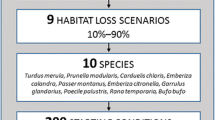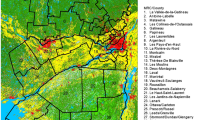Abstract
Context
Housing growth can alter suitability of matrix habitats around protected areas, strongly affecting movements of organisms and, consequently, threatening connectivity of protected area networks.
Objectives
Our goal was to quantify distribution and growth of housing around the U.S. Fish and Wildlife Service National Wildlife Refuge System. This is important information for conservation planning, particularly given promotion of habitat connectivity as a climate change adaptation measure.
Methods
We quantified housing growth from 1940 to 2000 and projected future growth to 2030 within three distances from refuges, identifying very low housing density open space, “opportunity areas” (contiguous areas with <6.17 houses/km2), both nationally and by USFWS administrative region. Additionally, we quantified number and area of habitat corridors within these opportunity areas in 2000.
Results
Our results indicated that the number and area of open space opportunity areas generally decreased with increasing distance from refuges and with the passage of time. Furthermore, total area in habitat corridors was much lower than in opportunity areas. In addition, the number of corridors sometimes exceeded number of opportunity areas as a result of habitat fragmentation, indicating corridors are likely vulnerable to land use change. Finally, regional differences were strong and indicated some refuges may have experienced so much housing growth already that they are effectively too isolated to adapt to climate change, while others may require extensive habitat restoration work.
Conclusions
Wildlife refuges are increasingly isolated by residential housing development, potentially constraining the movement of wildlife and, therefore, their ability to adapt to a changing climate.





Similar content being viewed by others
References
Blair R (1996) Land use and avian species diversity along an urban gradient. Ecol Appl 6:506–519
Brown DG, Johnson KM, Loveland TR, Theobald DM (2005) Rural land-use trends in the conterminous United States, 1950-2000. Ecol Appl 15:1851–1863
Carpenter S, Bennett E, Peterson G (2006) Scenarios for ecosystem services: an overview. Ecol Soc 11(1):29
Carr LW, Fahrig L (2001) Effect of road traffic on two amphibian species of differing vagility. Conserv Biol 15:1071–1078
Dale V, Archer S, Chang M, Ojima D (2005) Ecological impacts and mitigation strategies for rural land management. Ecol Appl 15:1879–1892
Eigenbrod F, Hecnar SJ, Fahrig L (2008) The relative effects of road traffic and forest cover on anuran populations. Biol Conserv 141:35–46
Fahrig L, Rytwinski T (2009) Effects of roads on animal abundance: an empirical review and synthesis. Ecol Soc 14(1):21
Fischer J, Lindenmayer DB (2007) Landscape modification and habitat fragmentation: a synthesis. Global Ecol Biogeogr 16:265–280
Flather CH, Knowles MS, Kendall IA (1998) Threatened and endangered species geography. Bioscience 48:365–376
Friesen LE, Eagles PFJ, MacKay RJ (1995) Effects of residential development on forest dwelling neotropical migrant songbirds. Conserv Biol 9:1408–1414
Fry J, Xian G, Jin S, Dewitz J, Homer C, Yang L, Barnes C, Herold N, Wickham J (2011) Completion of the 2006 National land cover database for the conterminous United States. Photogramm Eng Remote Sens 77:858–864
Gagne SA, Fahrig L (2010a) The trade-off between housing density and sprawl area: minimising impacts to forest breeding birds. Basic Appl Ecol 11:723–733
Gagne SA, Fahrig L (2010b) The trade-off between housing density and sprawl area: minimizing impacts to Carabid Beetles (Coleoptera: Carabidae). Ecol Soc 15(4):12
Gaston KJ, Jackson SF, Cantú-Salazar L, Cruz-Piñón G (2008) The ecological performance of protected areas. Ann Rev Ecol Evol Syst 39:93–113
Gavier-Pizarro GI, Radeloff VC, Stewart SI, Huebner CD, Keuler NS (2010) Rural housing is related to plant invasions in forests of southern Wisconsin, USA. Landscape Ecol 25:1505–1518
Griffith B, Scott JM, Adamcik R, Ashe D, Czech B, Fischman R, Gonzalez P, Lawler J, McGuire AD, Pidgorna A (2009) Climate change adaptation for the US National Wildlife Refuge System. Environ Manag 44:1043–1052
Hamilton CM, Martinuzzi S, Plantinga AJ, Radeloff VC, Lewis DJ, Thogmartin WE, Heglund PJ, Pidgeon AM (2013) Current and future land use around a nationwide protected area network. PLoS One 8(1):e55737
Hammer RB, Stewart SI, Hawbaker TJ, Radeloff VC (2009) Housing growth, forests, and public lands in Northern Wisconsin from 1940 to 2000. J Environ Manag 90:2690–2698
Hammer RB, Stewart SI, Winkler R, Radeloff VC, Voss PR (2004) Characterizing spatial and temporal residential density patterns across the U.S. Midwest, 1940–1990. Landsc Urban Plan 69:183–199
Hansen AJ, DeFries R (2007) Land use change around nature reserves: implications for sustaining biodiversity. Ecol Appl 17:972–973
Hansen AJ, Knight RL, Marzluff JM, Powell S, Brown K, Gude PH, Jones K (2005) Effects of exurban development on biodiversity: patterns, mechanisms, and research needs. Ecol Appl 15:1893–1905
Hawbaker TJ, Radeloff VC (2004) Roads and landscape pattern in northern Wisconsin based on a comparison of four road data sources. Conserv Biol 18:1233–1244
Hawbaker TJ, Radeloff VC, Clayton MK, Hammer RB, Gonzalez-Abraham CE (2006) Road development, housing growth, and landscape fragmentation in northern Wisconsin: 1937–1999. Ecol Appl 16:1222–1237
Joppa LN, Loarie SR, Pimm SL (2008) On the protection of “protected areas”. Proc Natl Acad Sci USA 105:6673–6678
Leinwand IIF, Theobald DM, Mitchell J, Knight RL (2010) Landscape dynamics at the public-private interface: a case study in Colorado. Landsc Urban Plan 97:182–193
Lindenmayer DB, Nix HA (1993) Ecological principles for the design of wildlife corridors. Conserv Biol 7:627–630
Liu J, Dietz T, Carpenter SR, Alberti M, Folke C, Moran E, Pell AN, Deadman P, Kratz T, Lubchenco J, Ostrom E, Ouvang Z, Provencher W, Redman CL, Schneider SH, Taylor WW (2007) Complexity of coupled human and natural systems. Science 317:1513–1516
Merenlender AM, Reed SE, Heise KL (2009) Exurban development influences woodland bird composition. Landsc Urban Plan 92:255–263
Meretsky VJ, Fischman RL, Karr JR, Ashe DM, Scott JM, Noss RF, Schroeder RL (2006) New directions in conservation for the National Wildlife Refuge System. Bioscience 56:135–143
Miller JR, Wiens JA, Hobbs NT, Theobald DM (2003) Effects of human settlement on bird communities in lowland riparian areas of Colorado (USA). Ecol Appl 13:1041–1059
Nusser SM, Goebel JJ (1997) The National Resources Inventory: a long-term multi-resource monitoring programme. Environ Ecol Stat 4:181–204
Patrick DA, Gibbs JP (2010) Population structure and movements of freshwater turtles across a road-density gradient. Landscape Ecol 25:791–801
Pidgeon AM, Radeloff VC, Flather CH, Lepczyk CA, Clayton MK, Hawbaker TJ, Hammer RB (2007) Associations of forest bird species richness with housing and landscape patterns across the USA. Ecol Appl 17:1989–2010
Predick KI, Turner MG (2008) Landscape configuration and flood frequency influence invasive shrubs in floodplain forests of the Wisconsin River (USA). J Ecol 96:91–102
Radeloff VC, Hammer RB, Stewart SI (2005) Rural and suburban sprawl in the US Midwest from 1940 to 2000 and its relation to forest fragmentation. Conserv Biol 19:793–805
Radeloff VC, Hammer RB, Voss PR, Hagen AE, Field DR, Mladenoff DJ (2001) Human demographic trends and landscape level forest management in the northwest Wisconsin Pine Barrens. For Sci 47:229–241
Radeloff VC, Nelson E, Plantinga AJ, Lewis DJ, Helmers D, Lawler JJ, Withey JC, Beaudry F, Martinuzzi S, Butsic V, Lonsdorf E, White D, Polasky S (2012) Economic-based projections of future land use in the conterminous United States under alternative policy scenarios. Ecol Appl 22:1036–1049
Radeloff VC, Stewart SI, Hawbaker TJ, Gimmi U, Pidgeon AM, Flather CH, Hammer RB, Helmers DP (2010) Housing growth in and near United States protected areas limits their conservation value. Proc Natl Acad Sci USA 107:940–945
Rothley K (2005) Finding and filling the “cracks” in resistance surfaces for least-cost modeling. Ecol Soc 10(1):4
Sala OE, Chapin FS, Armesto JJ, Berlow E, Bloomfield J, Dirzo R, Huber-Sanwald E, Huenneke LF, Jackson RB, Kinzig A, Leemans R, Lodge DM, Mooney HA, Oesterheld M, Poff NL, Sykes MT, Walker BH, Walker M, Wall DH (2000) Biodiversity—global biodiversity scenarios for the year 2100. Science 287:1770–1774
Scheffer M, Carpenter S, Foley JA, Folke C, Walker B (2001) Catastrophic shifts in ecosystems. Nature 413:591–596
Scott JM, Loveland T, Gergely K, Strittholt J, Staus N (2004) National Wildlife Refuge System: ecological context and integrity. Nat Res J 44:1041–1066
Sohl TL, Loveland TR, Sleeter BM, Sayler KL, Barnes CA (2010) Addressing foundational elements of regional land-use change forecasting. Landscape Ecol 25:233–247
Sutherland GD, Harestad AS, Price K, Lertzman KP (2000) Scaling of natal dispersal distances in terrestrial birds and mammals. Conserv Ecol 4(1):16
Tischendorf L, Fahrig L (2000) On the usage and measurement of landscape connectivity. Oikos 90:7–19
Van Vuuren DP, Sala OE, Pereira HM (2006) The future of vascular plant diversity under four global scenarios. Ecol Soc 11(2):25
Veloz S, Williams JW, Lorenz D, Notaro M, Vavrus S, Vimont DJ (2011) Identifying climatic analogs for Wisconsin under 21st-century climate-change scenarios. Clim Change 112:1037–1058
Wade AA, Theobald DM (2010) Residential development encroachment on US protected areas. Conserv Biol 24:151–161
Wiens JA (2009) Landscape ecology as a foundation for sustainable conservation. Landscape Ecol 24:1053–1065
Wilcove DS (1985) Nest predation in forest tracts and the decline of migratory songbirds. Ecology 66:1211–1214
Williams JW, Ordonez A, Notaro M, Veloz SAM, Vimont DJ (2012) Environmental and economic research and development program climatic analogs, climate velocity, and potential shifts in vegetation structure and biomass for Wisconsin under 21st-century climate-change scenarios Final Report. Madison
Acknowledgments
This research was supported by the U.S. Geological Survey/U.S. Fish and Wildlife Service Science Support Program Partnership. We very much appreciate the helpful comments of anonymous reviewers and the patience of the editorial staff of this journal, which greatly helped to improve an earlier version of this manuscript. Any use of trade, firm, or product names is for descriptive purposes only and does not imply endorsement by the U.S. Government. This publication represents the views of the authors and does not necessarily represent the views of the U.S. Fish and Wildlife Service.
Author information
Authors and Affiliations
Corresponding author
Electronic supplementary material
Below is the link to the electronic supplementary material.
Rights and permissions
About this article
Cite this article
Hamilton, C.M., Baumann, M., Pidgeon, A.M. et al. Past and predicted future effects of housing growth on open space conservation opportunity areas and habitat connectivity around National Wildlife Refuges. Landscape Ecol 31, 2175–2186 (2016). https://doi.org/10.1007/s10980-016-0392-8
Received:
Accepted:
Published:
Issue Date:
DOI: https://doi.org/10.1007/s10980-016-0392-8




